Groundwater Recharge Estimation in Upper Gelana Watershed, South-Western Main Ethiopian Rift Valley
Abstract
1. Introduction
2. Materials and Methods
2.1. Description of the Study Area
2.2. WetSpass Model
2.3. Study Framework
2.4. Materials and Software Used
2.5. Input Data for WetSpass
| No | Land Use Type | Runoff Vegetation | Runoff Class | Impervious Runoff Class | Vegetated Area | Bare Area | Impervious Area | Open Water Area | Root Depth | LAI | Min Stomatal Open | Interception Percentage | Vegetation Height |
|---|---|---|---|---|---|---|---|---|---|---|---|---|---|
| 21 | Agriculture | Crop | 1 | 0 | 0.8 | 0.2 | 0 | 0 | 0.4 | 4 | 180 | 15 | 0.6 |
| 7 | Bare land | Bare soil | 4 | 0 | 0 | 1 | 0 | 0 | 0.05 | 0 | 110 | 0 | 0.01 |
| 33 | Forest | Forest | 3 | 0 | 1 | 0 | 0 | 0 | 2 | 5 | 375 | 35 | 16 |
| 23 | Grassland | Grass | 2 | 0 | 1 | 0 | 0 | 0 | 0.3 | 2 | 100 | 10 | 0.2 |
| 2 | Built-up | Grass | 2 | 1 | 0.2 | 0 | 0.8 | 0 | 0.3 | 2 | 100 | 10 | 0.12 |
| 36 | Shrub land | Grass | 2 | 0 | 1 | 0 | 0 | 0 | 0.6 | 0.6 | 110 | 15 | 2 |
| No | Land Use Type | Runoff Vegetation | Runoff Class | Impervious Runoff Class | Vegetated Area | Bare Area | Impervious Area | Open Water Area | Root Depth | LAI | Min Stomatal Open | Interception Percentage | Vegetation Height |
|---|---|---|---|---|---|---|---|---|---|---|---|---|---|
| 21 | Agriculture | Crop | 1 | 0 | 0 | 1 | 0 | 0 | 0.35 | 0 | 180 | 0 | 0.6 |
| 7 | Bare land | Bare soil | 4 | 0 | 0 | 1 | 0 | 0 | 0.05 | 0 | 110 | 0 | 0.01 |
| 33 | Forest | Forest | 3 | 0 | 0.5 | 0.5 | 0 | 0 | 2 | 4.5 | 500 | 38 | 15 |
| 23 | Grassland | Grass | 2 | 0 | 1 | 0 | 0 | 0 | 0.3 | 2 | 100 | 10 | 0.2 |
| 1 | Built-up | Grass | 2 | 1 | 0.2 | 0 | 0.8 | 0 | 0.3 | 2 | 100 | 10 | 0.12 |
| 36 | Shrub land | Grass | 2 | 0 | 0.2 | 0.8 | 0 | 0 | 0.6 | 0 | 110 | 5 | 2 |
| Soil Type Number | Soil Texture | Field Capacity | Wilting Point | PWA | Residual Water Content | AI | Bare Soil ET | Tension Saturated Height | Pf_Sum | Pf_Win |
|---|---|---|---|---|---|---|---|---|---|---|
| 12 | Clay | 0.46 | 0.33 | 0.13 | 0.09 | 0.21 | 0.05 | 0.37 | 0.95 | 0.85 |
| 5 | Loam | 0.25 | 0.12 | 0.13 | 0.027 | 0.37 | 0.05 | 0.11 | 0.15 | 0.02 |
| 2 | Loamy sand | 0.15 | 0.07 | 0.08 | 0.035 | 0.47 | 0.05 | 0.09 | 0.09 | 0.01 |
| 3 | Sandy loam | 0.21 | 0.09 | 0.12 | 0.041 | 0.44 | 0.05 | 0.15 | 0.09 | 0.01 |
3. Results
3.1. Model Validation
3.2. Water Budget Components in the Upper Gelana Watershed
3.2.1. Interception Rate
3.2.2. Actual Evapotranspiration
3.2.3. Surface Runoff
3.2.4. Groundwater Recharge
4. Discussion
5. Conclusions
Author Contributions
Funding
Institutional Review Board Statement
Informed Consent Statement
Data Availability Statement
Acknowledgments
Conflicts of Interest
References
- Fenta, A.A.; Kifle, A.; Gebreyohannes, T.; Hailu, G. Spatial analysis of groundwater potential using remote sensing and GIS-based multi-criteria evaluation in Raya Valley, northern Ethiopia. Hydrogeol. J. 2015, 23, 195–206. [Google Scholar] [CrossRef]
- Shiklomanov, I.A. Appraisal and assessment of world water resources. Water Int. 2000, 25, 11–32. [Google Scholar] [CrossRef]
- Karimi, P.; Bastiaanssen, W.G. Spatial evapotranspiration, rainfall and land use data in water accounting—Part 1: Review of the accuracy of the remote sensing data. Hydrol. Earth Syst. Sci. 2015, 19, 507–532. [Google Scholar] [CrossRef]
- Raghunath, H.M. Hydrology: Principles, Analysis and Design; New Age International: New Delhi, India, 2006. [Google Scholar]
- Awulachew, S.B.; Yilma, A.D.; Loulseged, M.; Loiskandl, W.; Ayana, M.; Alamirew, T. Water Resources and Irrigation Development in Ethiopia; International Water Management Institute: Colombo, Sri Lanka, 2007; Volume 123. [Google Scholar]
- Kebede, S. Groundwater in Ethiopia: Features, Numbers and Opportunities; Springer Science & Business Media: Berlin, Germany, 2012. [Google Scholar]
- Busico, G.; Ntona, M.M.; Carvalho, S.C.; Patrikaki, O.; Voudouris, K.; Kazakis, N. Simulating future groundwater recharge in coastal and inland catchments. Water Resour. Manag. 2021, 35, 3617–3632. [Google Scholar] [CrossRef]
- Sowers, J.; Vengosh, A.; Weinthal, E. Climate change, water resources, and the politics of adaptation in the Middle East and North Africa. Clim. Change 2011, 104, 599–627. [Google Scholar] [CrossRef]
- Gebremeskel, G.; Kebede, A. Spatial estimation of long-term seasonal and annual groundwater resources: Application of WetSpass model in the Werii watershed of the Tekeze River Basin, Ethiopia. Phys. Geogr. 2017, 38, 338–359. [Google Scholar] [CrossRef]
- Ntona, M.M.; Busico, G.; Mastrocicco, M.; Kazakis, N. Modeling groundwater and surface water interaction: An overview of current status and future challenges. Sci. Total Environ. 2022, 846, 157355. [Google Scholar] [CrossRef] [PubMed]
- Scanlon, B.R.; Healy, R.W.; Cook, P.G. Choosing appropriate techniques for quantifying groundwater recharge. Hydrogeol. J. 2002, 10, 18–39. [Google Scholar] [CrossRef]
- De Vries, J.J.; Simmers, I. Groundwater recharge: An overview of processes and challenges. Hydrogeol. J. 2002, 10, 5–17. [Google Scholar] [CrossRef]
- Aish, A.M. Estimation of water balance components in the Gaza Strip with GIS based WetSpass model. Civ. Environ. Res. 2014, 6, 77–84. [Google Scholar]
- Armanuos, A.M.; Negm, A.; Yoshimura, C.; Valeriano, O.C.S. Application of WetSpass model to estimate groundwater recharge variability in the Nile Delta aquifer. Arab. J. Geosci. 2016, 9, 553. [Google Scholar] [CrossRef]
- Gebreyohannes, T.; De Smedt, F.; Hagos, M.; Gebresilassie, S.; Amare, K.; Kabeto, K.; Hussein, A.; Nyssen, J.; Bauer, H.; Moeyersons, J. Large-Scale Geological Mapping of the Geba Basin, Northern Ethiopia; VLIR-Mekelle University IUC Programme: Mekelle, Ethiopia, 2010. [Google Scholar]
- Abrar, H.; Legesse Kura, A.; Esayas Dube, E.; Likisa Beyene, D. AHP based analysis of groundwater potential in the western escarpment of the Ethiopian rift valley. Geol. Ecol. Landsc. 2021, 1952761. [Google Scholar] [CrossRef]
- Ayenew, T. Numerical groundwater flow modeling of the Central Main Ethiopian Rift lakes basin. SINET Ethiop. J. Sci. 2001, 24, 167–184. [Google Scholar] [CrossRef]
- Dinka, M.O. Delineating the drainage structure and sources of groundwater flux for Lake Basaka, Central Rift Valley Region of Ethiopia. Water 2017, 9, 797. [Google Scholar] [CrossRef]
- Ferede, M.; Haile, A.T.; Walker, D.; Gowing, J.; Parkin, G. Multi-method groundwater recharge estimation at Eshito micro-watershed, Rift Valley Basin in Ethiopia. Hydrol. Sci. J. 2020, 65, 1596–1605. [Google Scholar] [CrossRef]
- Jothimani, M.; Abebe, A.; Duraisamy, R. Groundwater potential zones identification in Arba Minch town, Rift Valley, Ethiopia, using geospatial and AHP tools. IOP Conf. Ser. Earth Environ. Sci. 2021, 822, 012048. [Google Scholar] [CrossRef]
- Meaza, H.; Frankl, A.; Demissie, B.; Poesen, J.; Zenebe, A.; Gebresamuel, G.; Asfaha, T.G.; Annys, S.; Van Eetvelde, V.; Jacob, M. Water balance components of the potential agricultural grabens along the Rift Valley in northern Ethiopia. J. Hydrol. Reg. Stud. 2019, 24, 100616. [Google Scholar] [CrossRef]
- Mechal, A.; Wagner, T.; Birk, S. Recharge variability and sensitivity to climate: The example of Gidabo River Basin, Main Ethiopian Rift. J. Hydrol. Reg. Stud. 2015, 4, 644–660. [Google Scholar] [CrossRef]
- Yifru, B.A.; Chung, I.-M.; Kim, M.-G.; Chang, S.W. Assessing the effect of land/use land cover and climate change on water yield and groundwater recharge in East African Rift Valley using integrated model. J. Hydrol. Reg. Stud. 2021, 37, 100926. [Google Scholar] [CrossRef]
- Molla, D.D.; Tegaye, T.A.; Fletcher, C.G. Simulated surface and shallow groundwater resources in the Abaya-Chamo Lake basin, Ethiopia using a spatially-distributed water balance model. J. Hydrol. Reg. Stud. 2019, 24, 100615. [Google Scholar] [CrossRef]
- Rwanga, S.; Ndambuki, J. Approach to quantify groundwater recharge using gis based water balance model: A review. Int. J. Adv. Agric. Environ Eng. (IJAAEE) 2017, 4, 166–172. [Google Scholar]
- Rwanga, S.S. A review on groundwater recharge estimation using Wetspass model. In Proceedings of the International Conference on Civil and Environmental Engineering, (CEE), Johannesburg, South Africa, 27–28 November 2013; p. 156. [Google Scholar]
- Yu, Z.; Yang, K.; Luo, Y.; Shang, C. Spatial-temporal process simulation and prediction of chlorophyll-a concentration in Dianchi Lake based on wavelet analysis and long-short term memory network. J. Hydrol. 2020, 582, 124488. [Google Scholar] [CrossRef]
- Yang, K.; Yu, Z.; Luo, Y.; Zhou, X.; Shang, C. Spatial-temporal variation of lake surface water temperature and its driving factors in Yunnan-Guizhou Plateau. Water Resour. Res. 2019, 55, 4688–4703. [Google Scholar] [CrossRef]
- Gebrechorkos, S.H.; Bernhofer, C.; Hülsmann, S. Climate change impact assessment on the hydrology of a large river basin in Ethiopia using a local-scale climate modelling approach. Sci. Total Environ. 2020, 742, 140504. [Google Scholar] [CrossRef]
- Molla, D.D.; Tegaye, T.A. Multivariate analysis of baseflow index in complex rift margin catchments: The case of Abaya-Chamo lakes basin, southern Ethiopia. Groundw. Sustain. Dev. 2019, 9, 100236. [Google Scholar] [CrossRef]
- Woldegabriel, G.; Aronson, J.L.; Walter, R.C. Geology, geochronology, and rift basin development in the central sector of the Main Ethiopia Rift. Geol. Soc. Am. Bull. 1990, 102, 439–458. [Google Scholar] [CrossRef]
- Batelaan, O.; De Smedt, F. WetSpass: A flexible, GIS based, distributed recharge methodology for regional groundwater. In Proceedings of the Impact of Human Activity on Groundwater Dynamics: Proceedings of an International Symposium (Symposium S3) Held During the Sixth Scientific Assembly of the International Association of Hydrological Sciences (IAHS), Maastricht, The Netherlands, 18–27 July 2001; p. 11. [Google Scholar]
- Batelaan, O.; De Smedt, F. GIS-based recharge estimation by coupling surface–subsurface water balances. J. Hydrol. 2007, 337, 337–355. [Google Scholar] [CrossRef]
- Gebreyohannes, T.; De Smedt, F.; Walraevens, K.; Gebresilassie, S.; Hussien, A.; Hagos, M.; Amare, K.; Deckers, J.; Gebrehiwot, K. Application of a spatially distributed water balance model for assessing surface water and groundwater resources in the Geba basin, Tigray, Ethiopia. J. Hydrol. 2013, 499, 110–123. [Google Scholar] [CrossRef]
- Combalicer, E.; Lee, S.; Ahn, S.; Kim, D.; Im, S. Comparing groundwater recharge and base flow in the Bukmoongol small-forested watershed, Korea. J. Earth Syst. Sci. 2008, 117, 553–566. [Google Scholar] [CrossRef]
- Risser, D.W.; Gburek, W.J.; Folmar, G.J. Comparison of recharge estimates at a small watershed in east-central Pennsylvania, USA. Hydrogeol. J. 2009, 17, 287–298. [Google Scholar] [CrossRef]
- Stewart, M.; Cimino, J.; Ross, M. Calibration of base flow separation methods with streamflow conductivity. Groundwater 2007, 45, 17–27. [Google Scholar] [CrossRef] [PubMed]
- Moriasi, D.N.; Arnold, J.G.; Van Liew, M.W.; Bingner, R.L.; Harmel, R.D.; Veith, T.L. Model evaluation guidelines for systematic quantification of accuracy in watershed simulations. Trans. ASABE 2007, 50, 885–900. [Google Scholar] [CrossRef]
- Yang, K.; Yu, Z.; Luo, Y. Analysis on driving factors of lake surface water temperature for major lakes in Yunnan-Guizhou Plateau. Water Res. 2020, 184, 116018. [Google Scholar] [CrossRef] [PubMed]
- Teklebirhan, A.; Dessie, N.; Tesfamichael, G. Groundwater recharge, evapotranspiration and surface runoff estimation using WetSpass modeling method in Illala catchment, northern Ethiopia. Momona Ethiop. J. Sci. 2012, 4, 96–110. [Google Scholar] [CrossRef]
- Meresa, E.; Taye, G. Estimation of groundwater recharge using GIS-based WetSpass model for Birki watershed, the eastern zone of Tigray, Northern Ethiopia. Sustain. Water Resour. Manag. 2019, 5, 1555–1566. [Google Scholar] [CrossRef]
- Dereje, B.; Nedaw, D. Groundwater recharge estimation using WetSpass modeling in Upper Bilate Catchment, southern Ethiopia. Momona Ethiop. J. Sci. 2019, 11, 37–51. [Google Scholar] [CrossRef]
- Tilahun, K.; Merkel, B.J. Estimation of groundwater recharge using a GIS-based distributed water balance model in Dire Dawa, Ethiopia. Hydrogeol. J. 2009, 17, 1443–1457. [Google Scholar] [CrossRef]

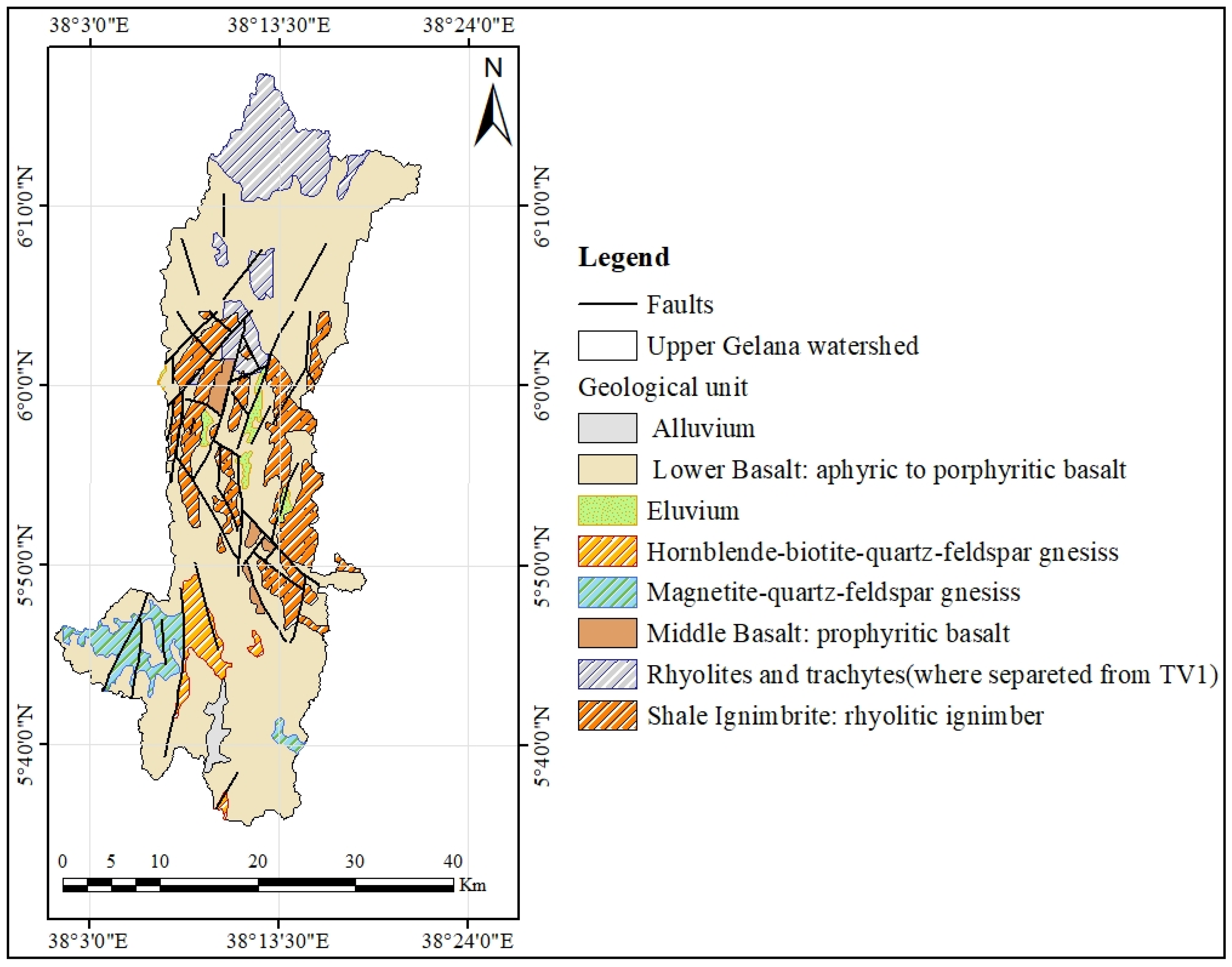

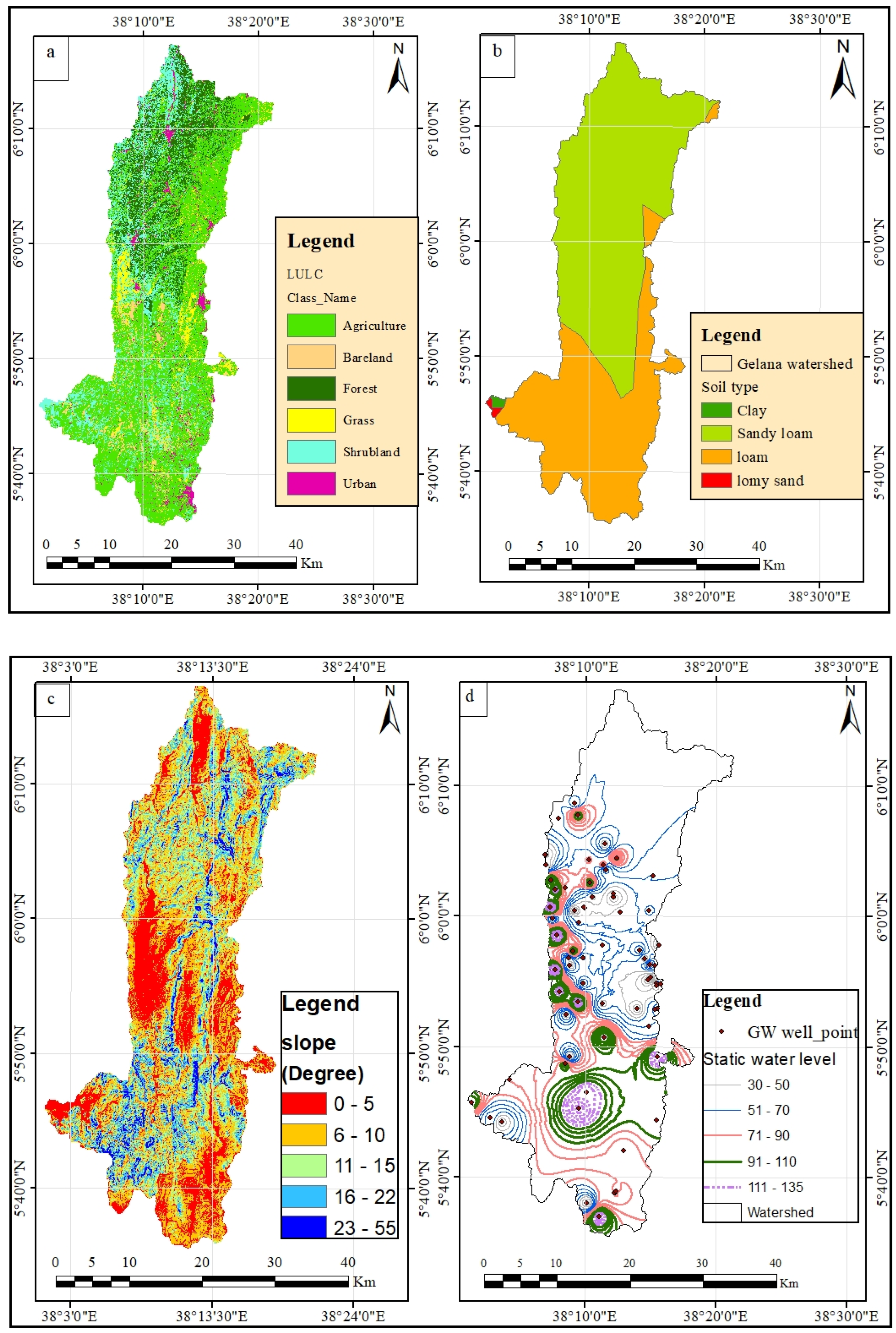
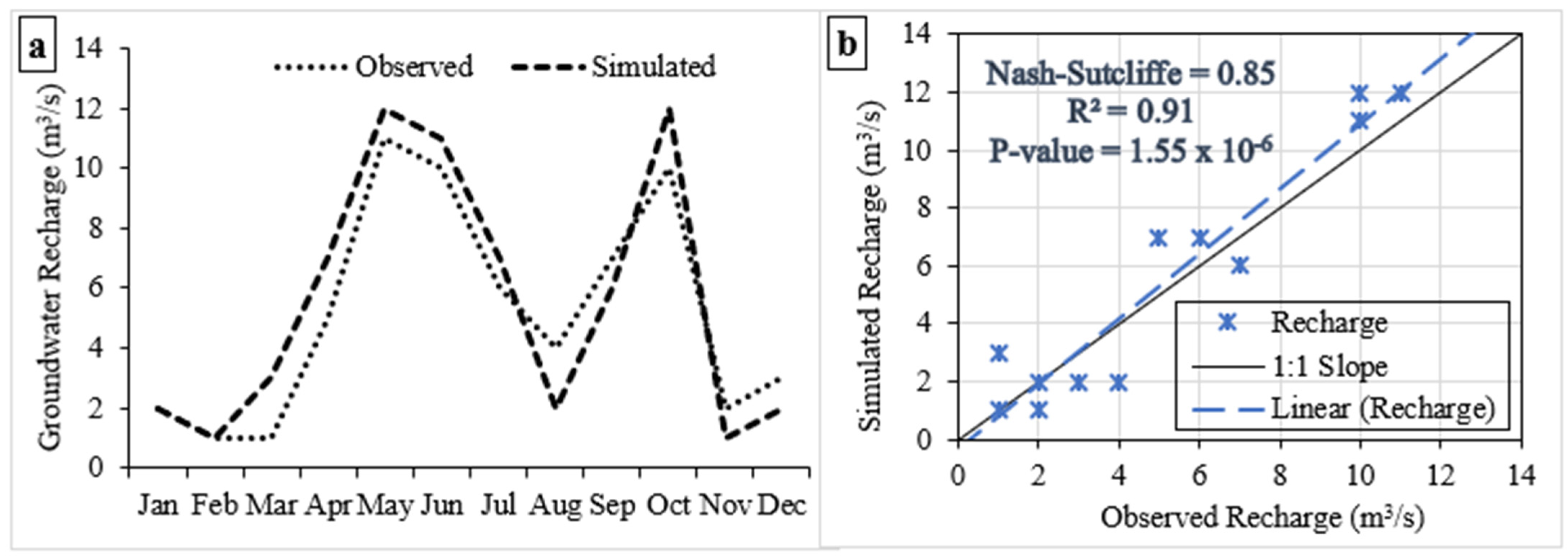
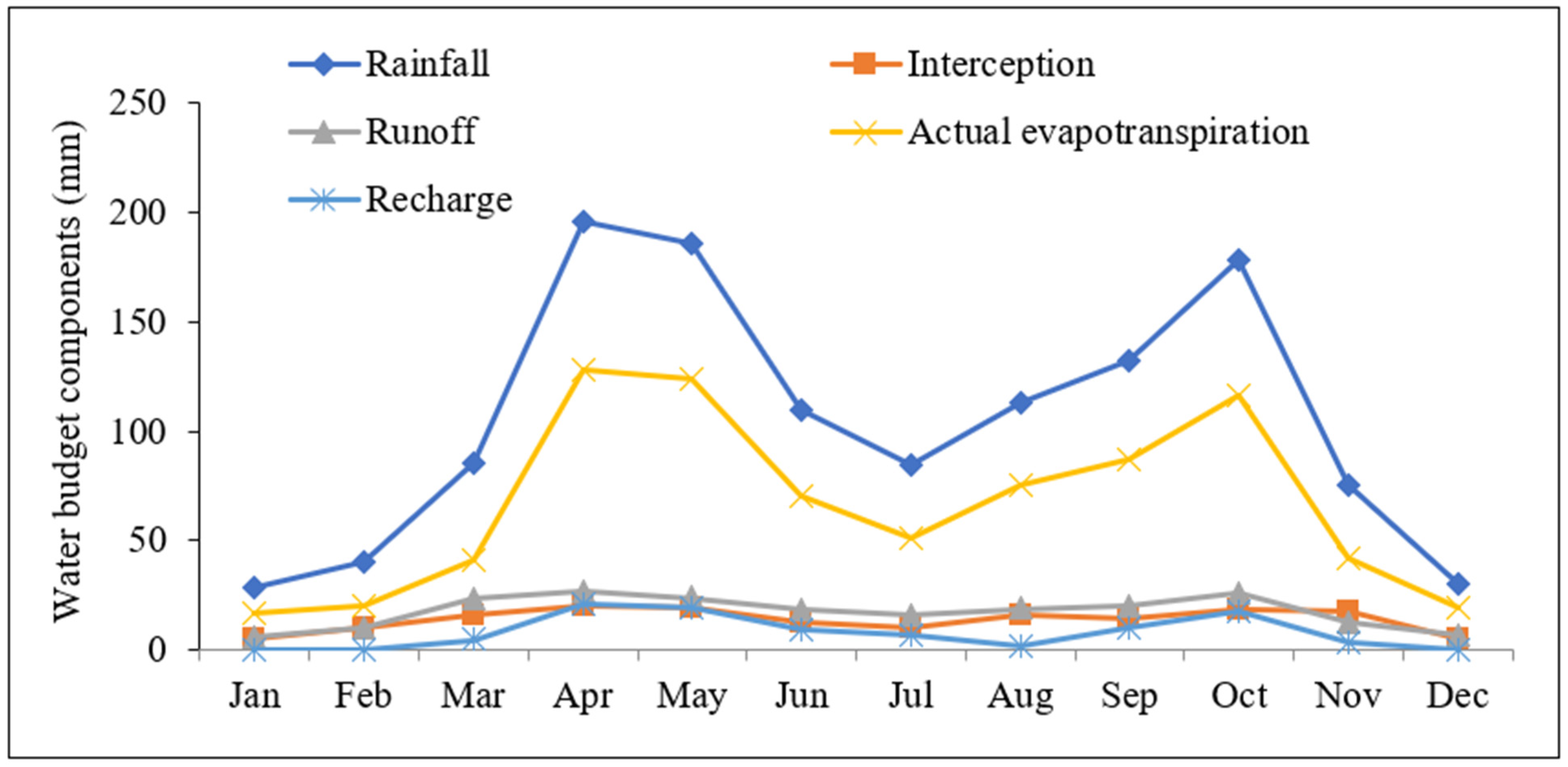
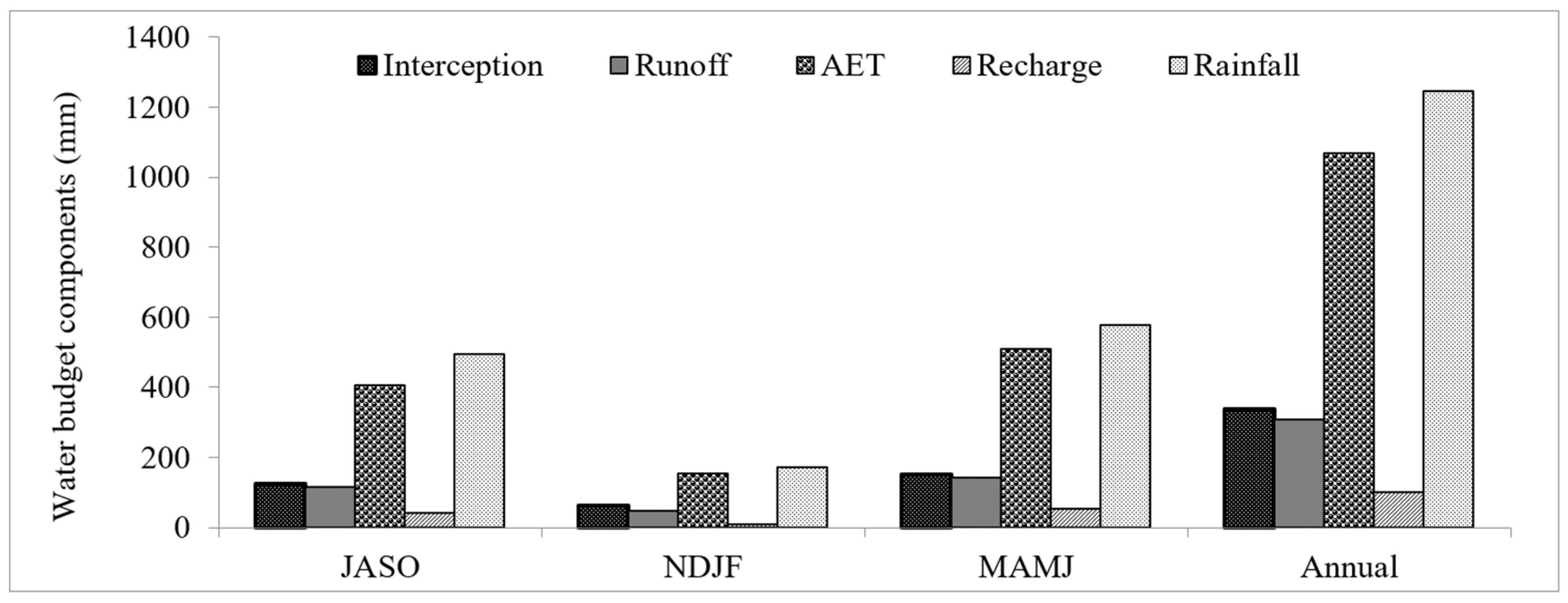

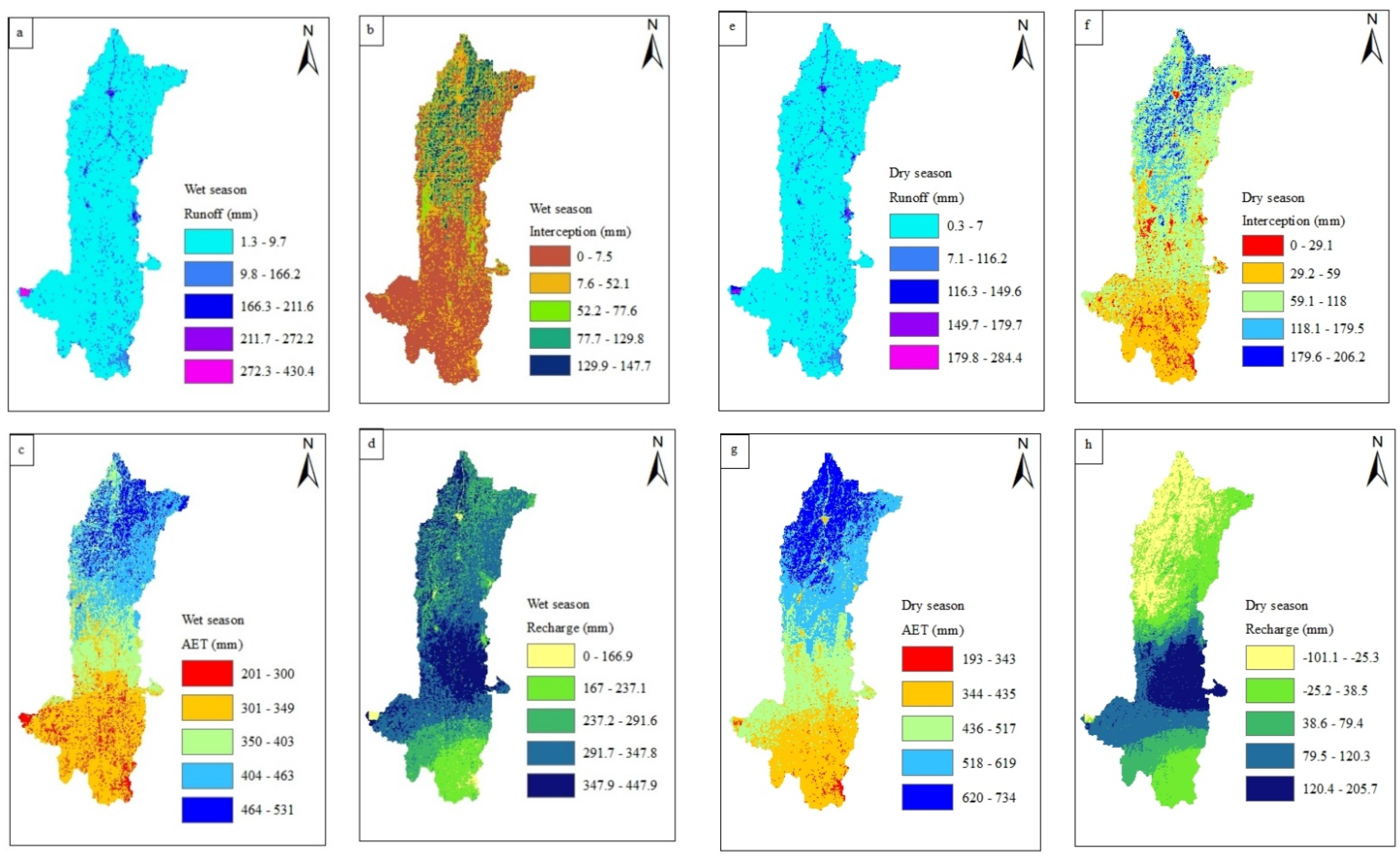
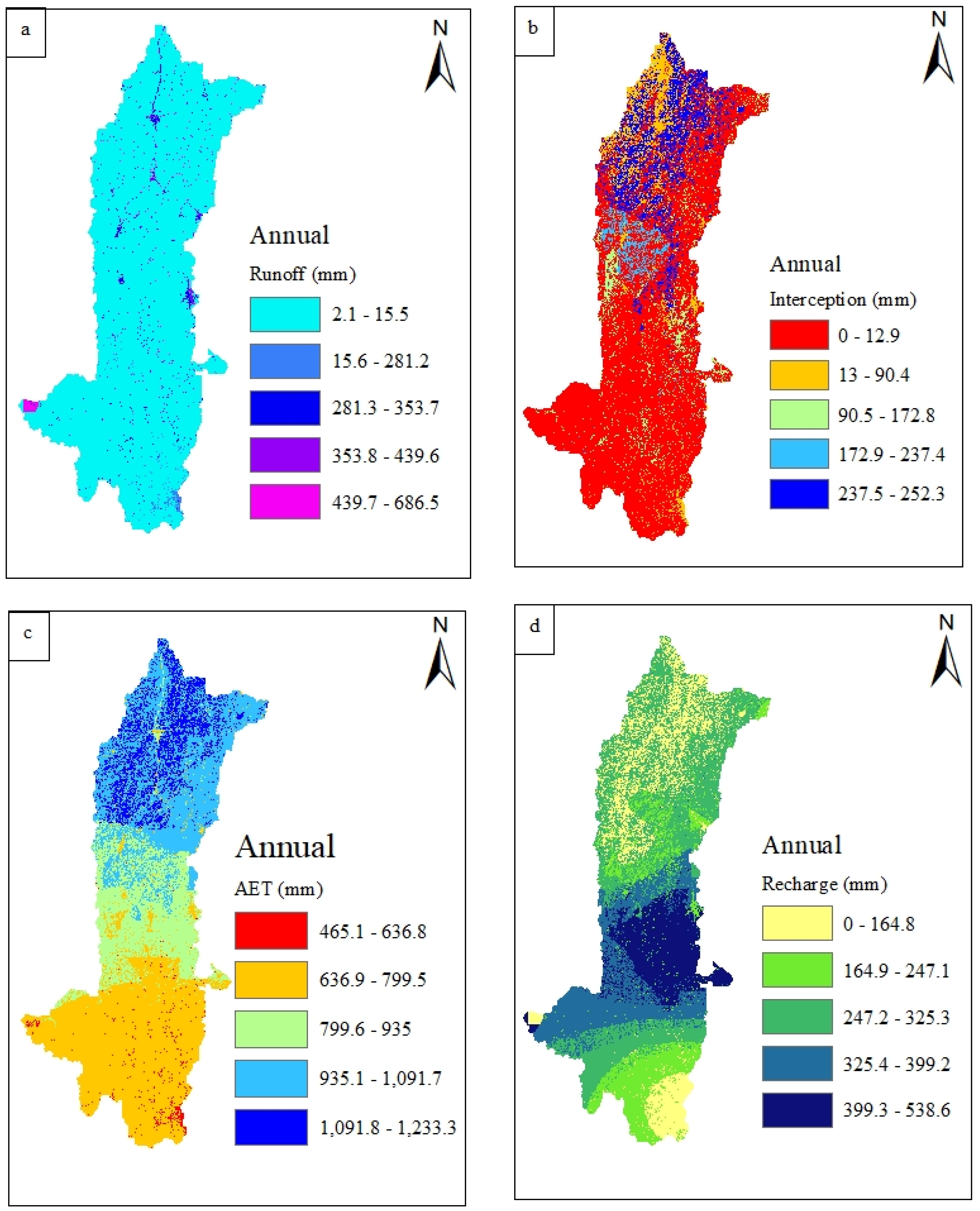
| No | Input | Source | Spatial Resolution * | Period and Frequency | Processing Tools/Methods |
|---|---|---|---|---|---|
| 1 | DEM | ALOS PALSAR (https://www.asf.alaska.edu) | 12.5 × 12.5 m | 2 November 2018 | ArcGIS10.3 |
| 2 | LULC map | Sentinel-2 https://scihub.compernicus.eu | 10 × 10 m | 23 February 2019 | ERDAS IMAGINE2013 and ArcGIS10.3 |
| 3 | Soil map | Ministry of Agriculture, Ethiopia | (12.5 × 12.5 m) | 2012 | ArcGIS10.3 |
| 4 | Slope map | Calculated from ALOS DEM | (12.5 × 12.5 m) | 2 November 2018 | ArcGIS10.3 |
| 5 | Rainfall, temperature, and wind speed map | Ethiopian Meteorological Agency | (12.5 × 12.5 m) | 1988–2019 Daily | Inverse distance weight (IDW) interpolation in ArcGIS10.3 |
| 6 | PET map | Calculated using FAO Penman–Monteith equation from observed climate data | (12.5 × 12.5 m) | 1988–2019 Daily | CROPWAT8 and (IDW) in ArcGIS10.3 |
| 7 | Groundwater depth map | Regional Water Office | (12.5 × 12.5 m) | 2017–2018 Monthly | (IDW) interpolation in ArcGIS10.3 |
| 8 | Soil, runoff, and LULC parameter lookup table | WetSpass User Guide and literature review | |||
| 9 | Streamflow | Ministry of Water Resources and Energy (MoWRE), Ethiopia | 1990–2019 Daily | BFI+3 tools |
| Month | Rainfall (mm) | Interception (mm) | Runoff (mm) | ET (mm) | Recharge (mm) | Interception/Rainfall (%) | Runoff/Rainfall (%) | ET/Rainfall (%) | Recharge/Rainfall (%) |
|---|---|---|---|---|---|---|---|---|---|
| Jan | 28 | 1.5 | 6 | 21 | 0 | 17.23 | 20.49 | 59.78 | 0.00 |
| Feb | 40 | 10 | 10 | 20 | 0 | 24.54 | 25.05 | 50.38 | 0.00 |
| Mar | 85 | 16 | 24 | 41 | 5 | 18.49 | 27.91 | 47.85 | 5.46 |
| Apr | 196 | 20 | 27 | 128 | 21 | 10.20 | 13.79 | 65.47 | 10.76 |
| May | 186 | 19 | 24 | 124 | 19 | 10.45 | 12.84 | 66.57 | 10.23 |
| Jun | 110 | 12 | 19 | 70 | 9 | 11.14 | 17.04 | 64.14 | 8.12 |
| Jul | 84 | 10 | 16 | 51 | 6 | 12.25 | 18.84 | 60.46 | 7.59 |
| Aug | 113 | 16 | 19 | 76 | 2 | 13.81 | 16.74 | 67.00 | 1.61 |
| Sep | 132 | 14 | 20 | 87 | 10 | 10.56 | 15.46 | 66.08 | 7.87 |
| Oct | 179 | 19 | 26 | 116 | 18 | 10.48 | 14.41 | 65.20 | 10.04 |
| Nov | 75 | 18 | 13 | 42 | 3 | 23.33 | 16.98 | 55.55 | 4.04 |
| Dec | 30 | 1.5 | 6 | 23 | 0 | 15.91 | 21.72 | 63.78 | 0.00 |
| Land Use and Soil | Clay | Loam | Loamy Sand | Sandy Loam | Mean | STD |
|---|---|---|---|---|---|---|
| Agriculture | 537.9 | 762.0 | 688.2 | 944.8 | 733.2 | 169.1 |
| Bare land | 491.4 | 718.4 | 623.5 | 787.1 | 655.1 | 128.1 |
| Built-up | 631.7 | 601.5 | 612.6 | 762.5 | 652.1 | 74.7 |
| Forest | 792.3 | 851.8 | - | 1131.5 | 925.2 | 181.1 |
| Grassland | 775.1 | 803.6 | - | 939.9 | 839.6 | 88.1 |
| Shrubland | 647.6 | 736.8 | 700.3 | 951.0 | 758.9 | 133.2 |
| Mean | 646.0 | 745.7 | 656.2 | 919.5 | ||
| STD | 121.6 | 185.4 | 144.5 | 133.5 |
| Land Use and Soil | Clay | Loam | Loamy Sand | Sandy Loam | Mean | STD |
|---|---|---|---|---|---|---|
| Agriculture | 608.3 | 15.0 | 26.7 | 10.2 | 165.1 | 295.6 |
| Bare land | 649.6 | 14.2 | 7.1 | 9.3 | 170.1 | 319.7 |
| Built-up | 475.0 | 260.9 | 239.1 | 322.0 | 324.2 | 106.5 |
| Forest | 369.1 | 7.8 | - | 4.4 | 127.1 | 209.6 |
| Grassland | 380.5 | 7.6 | - | 4.7 | 130.9 | 216.2 |
| Shrubland | 504.2 | 10.4 | 16.6 | 7.0 | 134.6 | 246.5 |
| Mean | 497.8 | 52.7 | 72.4 | 59.6 | ||
| STD | 115.0 | 102.1 | 111.41 | 128.6 |
| Land Use and Soil | Clay | Loam | Loamy Sand | Sandy Loam | Mean | STD |
|---|---|---|---|---|---|---|
| Agriculture | 8.6 | 286.5 | 433.8 | 326.0 | 262.0 | 184.4 |
| Bare land | 5.3 | 316.0 | 508.3 | 460.6 | 322.6 | 226.8 |
| Built-up | 1.6 | 157.1 | 240.8 | 165.8 | 147.1 | 89.9 |
| Forest | 19.9 | 299.0 | - | 153.3 | 157.4 | 139.6 |
| Grassland | 14.4 | 302.2 | - | 313.3 | 209.3 | 170.6 |
| Shrubland | 4.0 | 334.4 | 435.4 | 316.4 | 272.1 | 187.5 |
| Mean | 11.0 | 282.6 | 404.6 | 289.2 | ||
| STD | 9.6 | 63.6 | 114.6 | 114.7 |
Disclaimer/Publisher’s Note: The statements, opinions and data contained in all publications are solely those of the individual author(s) and contributor(s) and not of MDPI and/or the editor(s). MDPI and/or the editor(s) disclaim responsibility for any injury to people or property resulting from any ideas, methods, instructions or products referred to in the content. |
© 2023 by the authors. Licensee MDPI, Basel, Switzerland. This article is an open access article distributed under the terms and conditions of the Creative Commons Attribution (CC BY) license (https://creativecommons.org/licenses/by/4.0/).
Share and Cite
Demissie, E.S.; Gashaw, D.Y.; Altaye, A.A.; Demissie, S.S.; Ayele, G.T. Groundwater Recharge Estimation in Upper Gelana Watershed, South-Western Main Ethiopian Rift Valley. Sustainability 2023, 15, 1763. https://doi.org/10.3390/su15031763
Demissie ES, Gashaw DY, Altaye AA, Demissie SS, Ayele GT. Groundwater Recharge Estimation in Upper Gelana Watershed, South-Western Main Ethiopian Rift Valley. Sustainability. 2023; 15(3):1763. https://doi.org/10.3390/su15031763
Chicago/Turabian StyleDemissie, Endale Siyoum, Demisachew Yilma Gashaw, Andarge Alaro Altaye, Solomon S. Demissie, and Gebiaw T. Ayele. 2023. "Groundwater Recharge Estimation in Upper Gelana Watershed, South-Western Main Ethiopian Rift Valley" Sustainability 15, no. 3: 1763. https://doi.org/10.3390/su15031763
APA StyleDemissie, E. S., Gashaw, D. Y., Altaye, A. A., Demissie, S. S., & Ayele, G. T. (2023). Groundwater Recharge Estimation in Upper Gelana Watershed, South-Western Main Ethiopian Rift Valley. Sustainability, 15(3), 1763. https://doi.org/10.3390/su15031763






